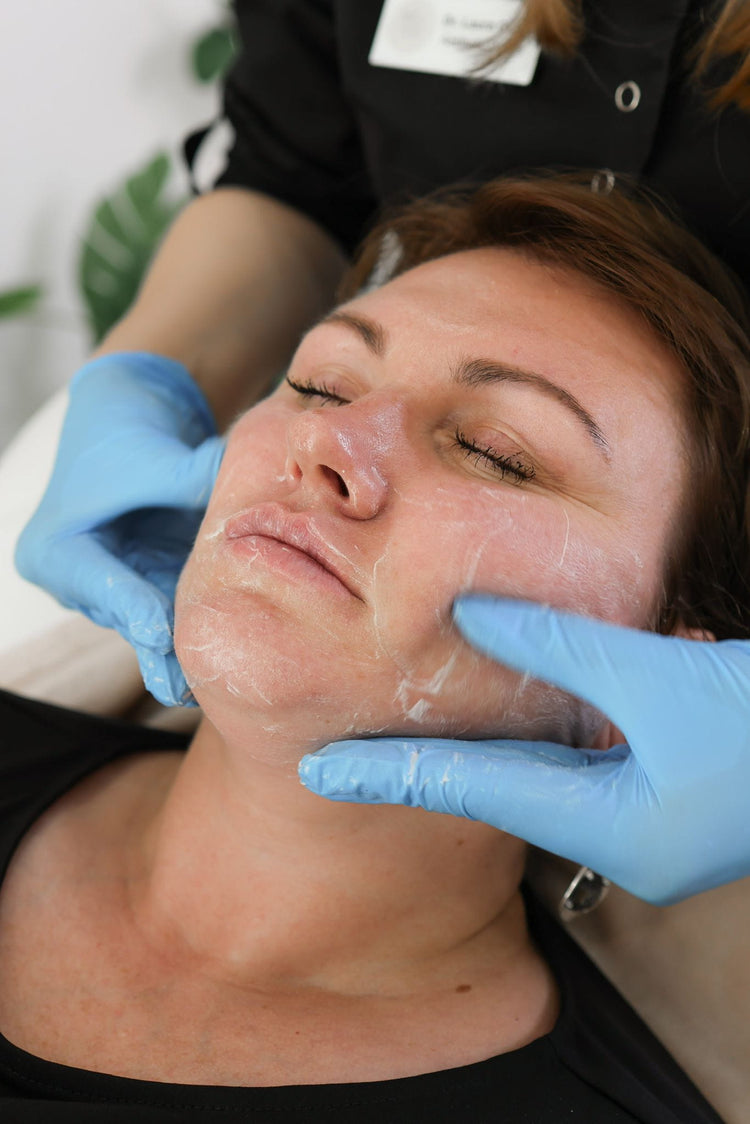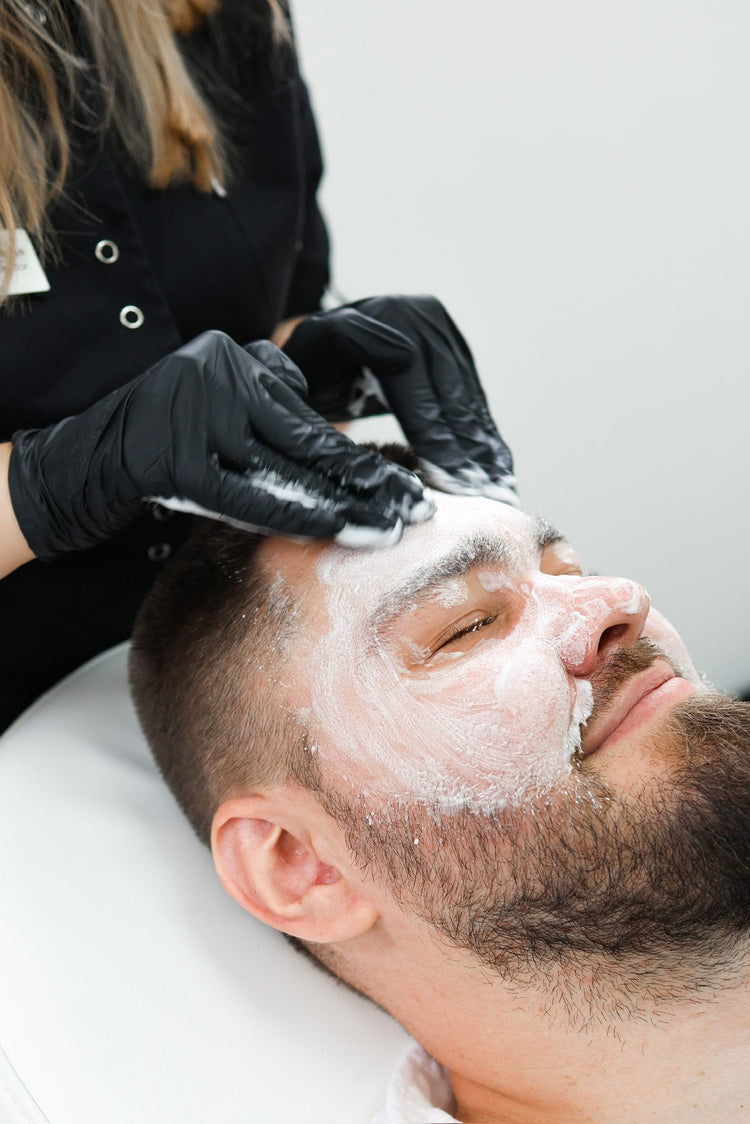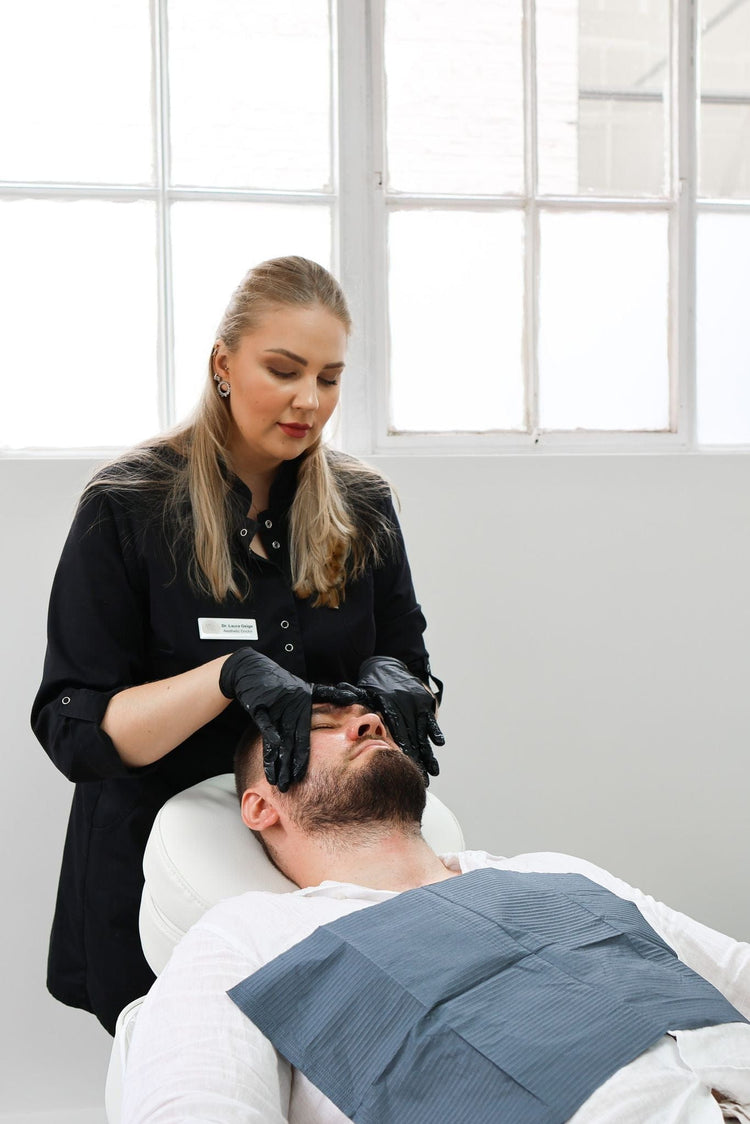Understanding Dry and Dehydrated Skin
Dry and dehydrated skin are common concerns that can leave skin feeling tight, rough, and flaky. While often used interchangeably, these conditions have distinct causes and require different approaches to skincare. Understanding the difference between them is crucial for effectively treating the issue and achieving healthy, radiant skin.
Signs and Symptoms
Dry skin results from a lack of sufficient oil (sebum) production, leading to moisture loss. This can be caused by genetics, environmental factors like dry weather or harsh climates, and certain medical conditions. Dehydrated skin, on the other hand, refers to a temporary shortage of water within the skin’s layers. It can be triggered by factors like insufficient hydration, excessive exposure to sunlight or wind, or using harsh skincare products that strip away moisture.

Recognizing the signs and symptoms of each condition is crucial for addressing them effectively. Dry skin typically presents as tight, rough, scaly patches, particularly on the face, hands, and legs. It may also appear dull and flaky with visible lines or wrinkles. Dehydrated skin, while similar, often feels more taut and itchy, with a temporary appearance of fine lines that soften when hydrated. Fine lines around the eyes, mouth, and forehead are common signs of dehydration.
Skin treatment consultations play a vital role in diagnosing and addressing dry or dehydrated skin concerns. A dermatologist or esthetician can assess your individual needs, determine the underlying cause, and recommend tailored skincare solutions. This may include specific moisturizing creams, serums, or treatments like chemical peels or facials to replenish moisture and restore the skin’s balance.
Causes of Dryness and Dehydration
During a consultation, a professional will take your medical history, examine your skin, and ask about your lifestyle and skincare routine. They can differentiate between dry and dehydrated skin based on these factors and recommend appropriate solutions.
For dry skin, the focus is on replenishing lost oils. This may involve recommending thicker moisturizers containing ingredients like ceramides, hyaluronic acid, or glycerin to lock in moisture. Products with occlusives like shea butter or petrolatum can also be beneficial. Lifestyle changes like using a humidifier and avoiding hot showers can further help.
Dehydrated skin requires immediate hydration replenishment. A dermatologist might suggest hydrating serums with humectants like hyaluronic acid, which attract moisture from the air. Facial mists and drinking plenty of water are also essential. They may recommend avoiding harsh skincare products that strip the skin’s natural oils.
Consultation Process
Seeking professional guidance through a skin treatment consultation is a valuable step in addressing concerns about dry or dehydrated skin. These consultations provide personalized assessments and tailored solutions to restore the skin’s health and balance.
Initial Assessment
Skin treatment consultations offer a comprehensive approach to understanding and addressing dry or dehydrated skin.
- During an initial assessment, a dermatologist or esthetician will review your medical history, examine your skin, and inquire about your lifestyle and skincare routine.
- This information helps them differentiate between dry and dehydrated skin based on factors like the presence of scales, tightness, itchiness, and other specific characteristics.
- Once the cause is identified, they can recommend appropriate treatments and products tailored to your unique needs.
Skin History and Lifestyle Factors
Skin treatment consultations are crucial for addressing dry or dehydrated skin because they allow a professional to assess the underlying cause and recommend personalized solutions.
During the consultation, a dermatologist or esthetician will gather information about your medical history, examine your skin’s condition, and inquire about your lifestyle and skincare routine. Factors like exposure to sunlight or wind, use of harsh skincare products, and diet all contribute to skin health. This comprehensive approach helps determine whether your skin is truly dry due to insufficient oil production or dehydrated from a lack of water.
Armed with this knowledge, the professional can recommend specific treatments and products tailored to your needs. For dry skin, this might involve recommending thicker moisturizers containing ingredients like ceramides, hyaluronic acid, or glycerin. Dehydrated skin often benefits from hydrating serums with humectants like hyaluronic acid, facial mists, and increased water intake.
Clinical Examination
Skin treatment consultations are crucial for addressing dry or dehydrated skin because they allow a professional to assess the underlying cause and recommend personalized solutions.
During the consultation, a dermatologist or esthetician will gather information about your medical history, examine your skin’s condition, and inquire about your lifestyle and skincare routine. Factors like exposure to sunlight or wind, use of harsh skincare products, and diet all contribute to skin health. This comprehensive approach helps determine whether your skin is truly dry due to insufficient oil production or dehydrated from a lack of water.
Armed with this knowledge, the professional can recommend specific treatments and products tailored to your needs. For dry skin, this might involve recommending thicker moisturizers containing ingredients like ceramides, hyaluronic acid, or glycerin. Dehydrated skin often benefits from hydrating serums with humectants like hyaluronic acid, facial mists, and increased water intake.

Targeted Solutions
Dry and dehydrated skin are common concerns that can be effectively addressed through personalized skincare solutions found in skin treatment consultations.
During a consultation, a dermatologist or esthetician will assess your individual needs by reviewing your medical history, examining your skin, and inquiring about your lifestyle and skincare routine. This detailed approach allows them to differentiate between dry and dehydrated skin based on factors like the presence of scales, tightness, itchiness, and other specific characteristics.
Based on their assessment, they can recommend appropriate treatments and products tailored to your unique situation. For example, for dry skin, they might suggest thicker moisturizers containing ceramides, hyaluronic acid, or glycerin, while dehydrated skin may benefit from hydrating serums with humectants like hyaluronic acid, facial mists, and increased water intake.
Skin treatment consultations provide a comprehensive understanding of your skin’s needs, ensuring you receive targeted solutions for achieving healthy, radiant skin.
Personalized Skincare Regimen
Skin treatment consultations are essential for addressing dry or dehydrated skin because they allow a professional to assess the underlying cause and recommend personalized solutions. During the consultation, a dermatologist or esthetician will gather information about your medical history, examine your skin’s condition, and inquire about your lifestyle and skincare routine.
This comprehensive approach helps determine whether your skin is truly dry due to insufficient oil production or dehydrated from a lack of water. Factors like exposure to sunlight or wind, use of harsh skincare products, and diet all contribute to skin health. Armed with this knowledge, the professional can recommend specific treatments and products tailored to your needs.
For dry skin, they might suggest thicker moisturizers containing ingredients like ceramides, hyaluronic acid, or glycerin. Dehydrated skin often benefits from hydrating serums with humectants like hyaluronic acid, facial mists, and increased water intake. Skin treatment consultations ensure you receive targeted solutions for achieving healthy, radiant skin.
In-office Treatments
Dry and dehydrated skin are common concerns that can be effectively addressed through personalized skincare solutions found in skin treatment consultations.
During a consultation, a dermatologist or esthetician will assess your individual needs by reviewing your medical history, examining your skin, and inquiring about your lifestyle and skincare routine. This detailed approach allows them to differentiate between dry and dehydrated skin based on factors like the presence of scales, tightness, itchiness, and other specific characteristics.
Based on their assessment, they can recommend appropriate treatments and products tailored to your unique situation. For example, for dry skin, they might suggest thicker moisturizers containing ceramides, hyaluronic acid, or glycerin, while dehydrated skin may benefit from hydrating serums with humectants like hyaluronic acid, facial mists, and increased water intake.
Skin treatment consultations provide a comprehensive understanding of your skin’s needs, ensuring you receive targeted solutions for achieving healthy, radiant skin.
Treatment Options
Treatment options for dry or dehydrated skin vary depending on the underlying cause. A skin treatment consultation is essential to determine the specific needs of your skin.
Moisturizing Products
Treating dry or dehydrated skin requires a personalized approach. During a skin treatment consultation, a dermatologist or esthetician will assess your individual needs and recommend tailored solutions.
Moisturizing products play a crucial role in addressing both dry and dehydrated skin. For dry skin, thicker creams containing ingredients like ceramides, hyaluronic acid, or glycerin are beneficial as they help lock in moisture and restore the skin’s protective barrier.
Individuals with dehydrated skin can benefit from hydrating serums with humectants such as hyaluronic acid, which attracts moisture from the air. Facial mists can also provide an instant boost of hydration.
Ingredients to Look For
Treatment options for dry or dehydrated skin vary depending on the underlying cause. A skin treatment consultation is essential to determine the specific needs of your skin.
Moisturizing products play a crucial role in addressing both dry and dehydrated skin. For dry skin, thicker creams containing ingredients like ceramides, hyaluronic acid, or glycerin are beneficial as they help lock in moisture and restore the skin’s protective barrier.
Individuals with dehydrated skin can benefit from hydrating serums with humectants such as hyaluronic acid, which attracts moisture from the air. Facial mists can also provide an instant boost of hydration.
Ingredients to look for in skincare products for dry skin include ceramides, which help repair and strengthen the skin barrier; hyaluronic acid, which draws moisture from the air; glycerin, which attracts and retains moisture; and shea butter or petrolatum, which form a protective occlusive layer on the skin.
For dehydrated skin, focus on ingredients that attract and retain moisture. Hyaluronic acid is a key humectant, drawing water into the skin. Glycerin also helps keep moisture locked in, while aloe vera soothes and hydrates.
Hydrating Facials
Hydrating facials are a popular treatment option for addressing dry or dehydrated skin. These facials involve the application of hydrating serums, masks, and moisturizers designed to replenish moisture levels and improve the skin’s overall appearance.
During a hydrating facial, estheticians often use products containing humectants like hyaluronic acid, which attract water molecules from the air, increasing the skin’s hydration levels. Other common ingredients include aloe vera, known for its soothing and moisturizing properties, and antioxidants that protect the skin from environmental damage.

Chemical Peels
Chemical peels are a popular treatment option for addressing both dry and dehydrated skin. They work by exfoliating the top layers of skin, revealing smoother, more hydrated skin underneath.
There are different types of chemical peels, varying in strength and ingredients. Superficial peels, often containing alpha-hydroxy acids (AHAs) like glycolic acid or lactic acid, primarily target the outermost layer of skin. These peels can help improve hydration, reduce fine lines, and brighten the complexion.
Medium-depth peels, which utilize trichloroacetic acid (TCA), penetrate deeper into the skin and are more effective in addressing pigmentation issues, wrinkles, and acne scarring, along with improving hydration.
A dermatologist will determine the best type of chemical peel for your specific needs based on your skin type, concerns, and medical history.
Microneedling
Treatment options for dry or dehydrated skin vary depending on the underlying cause. A skin treatment consultation is essential to determine the specific needs of your skin.
Moisturizing products play a crucial role in addressing both dry and dehydrated skin. For dry skin, thicker creams containing ingredients like ceramides, hyaluronic acid, or glycerin are beneficial as they help lock in moisture and restore the skin’s protective barrier.
Individuals with dehydrated skin can benefit from hydrating serums with humectants such as hyaluronic acid, which attracts moisture from the air. Facial mists can also provide an instant boost of hydration.
- Hydrating Facials: These facials involve the application of hydrating serums, masks, and moisturizers designed to replenish moisture levels and improve the skin’s overall appearance.
- Chemical Peels: Chemical peels exfoliate the top layers of skin, revealing smoother, more hydrated skin underneath.
- Microneedling:
Home Care Tips
Skin treatment consultations are crucial for addressing concerns about dry or dehydrated skin. During a consultation, a dermatologist or esthetician will assess your individual needs through a review of your medical history, an examination of your skin, and inquiries about your lifestyle and skincare routine.
This comprehensive approach allows them to determine the underlying cause of your skin’s dryness or dehydration. They can then recommend personalized treatments and product recommendations tailored to your specific concerns. Whether it’s thicker moisturizers for dry skin or hydrating serums for dehydrated skin, a consultation ensures you receive targeted solutions for achieving healthy, radiant skin.
Skincare Routine Adjustments
Dry and dehydrated skin are common concerns that can leave skin feeling tight, rough, and flaky. While often used interchangeably, these conditions have distinct causes and require different approaches to skincare. Understanding the difference between them is crucial for effectively treating the issue and achieving healthy, radiant skin.
Skin treatment consultations play a vital role in diagnosing and addressing dry or dehydrated skin concerns. A dermatologist or esthetician can assess your individual needs, determine the underlying cause, and recommend tailored skincare solutions. This may include specific moisturizing creams, serums, or treatments like chemical peels or facials to replenish moisture and restore the skin’s balance.
- During an initial assessment, a dermatologist or esthetician will review your medical history, examine your skin, and inquire about your lifestyle and skincare routine.
- This information helps them differentiate between dry and dehydrated skin based on factors like the presence of scales, tightness, itchiness, and other specific characteristics.
- Once the cause is identified, they can recommend appropriate treatments and products tailored to your unique needs.
Dry skin results from a lack of sufficient oil (sebum) production, leading to moisture loss. This can be caused by genetics, environmental factors like dry weather or harsh climates, and certain medical conditions. Dehydrated skin, on the other hand, refers to a temporary shortage of water within the skin’s layers. It can be triggered by factors like insufficient hydration, excessive exposure to sunlight or wind, or using harsh skincare products that strip away moisture.
Recognizing the signs and symptoms of each condition is crucial for addressing them effectively. Dry skin typically presents as tight, rough, scaly patches, particularly on the face, hands, and legs. It may also appear dull and flaky with visible lines or wrinkles. Dehydrated skin, while similar, often feels more taut and itchy, with a temporary appearance of fine lines that soften when hydrated. Fine lines around the eyes, mouth, and forehead are common signs of dehydration.
Skin treatment consultations provide a comprehensive understanding of your skin’s needs, ensuring you receive targeted solutions for achieving healthy, radiant skin.
A dermatologist or esthetician will assess your individual needs by reviewing your medical history, examining your skin, and inquiring about your lifestyle and skincare routine. This detailed approach allows them to differentiate between dry and dehydrated skin based on factors like the presence of scales, tightness, itchiness, and other specific characteristics.
Treatment options for dry or dehydrated skin vary depending on the underlying cause. A skin treatment consultation is essential to determine the specific needs of your skin.
Cleansing Practices
Exfoliation Techniques
Skin care tips are essential for maintaining healthy and radiant skin. There are many different ways to take care of your skin, but some key tips include:
Cleansing: Cleanse your face twice daily with a gentle cleanser that is appropriate for your skin type. Avoid harsh soaps or detergents as they can strip the skin of its natural oils.
Exfoliating: Exfoliate 1-2 times per week to remove dead skin cells and promote cell turnover. This can help improve skin texture and allow skincare products to penetrate better.
- Physical exfoliation:
- Chemical exfoliation:
Involves using scrubs with small granules to physically remove dead skin cells. Popular options include sugar scrubs, salt scrubs, or enzymatic exfoliants.
Uses acids like alpha-hydroxy acids (AHAs) or beta-hydroxy acids (BHAs) to dissolve the bonds holding dead skin cells together.
Moisturizing: Moisturize daily, even if you have oily skin. Choose a moisturizer that is appropriate for your skin type and apply it after cleansing and toning.
Sun protection: Protect your skin from the sun’s harmful rays by wearing sunscreen with an SPF of 30 or higher every day, even on cloudy days.
Hydration: Drink plenty of water throughout the day to keep your skin hydrated from within.
Diet and Lifestyle: Eat a healthy diet rich in fruits, vegetables, and antioxidants. Get enough sleep, manage stress, and avoid smoking as these factors can all impact skin health.
Professional Treatments:
Consider professional treatments like facials or chemical peels for deeper cleansing and rejuvenation. Consult with a dermatologist or esthetician to determine the best options for your skin type.
Lifestyle Modifications
Don’t forget to protect your skin from the sun by wearing sunscreen every day, even on cloudy days, as UV rays can penetrate through clouds.
- Cleansing: Cleanse your face twice daily with a gentle cleanser that is appropriate for your skin type. Avoid harsh soaps or detergents as they can strip the skin of its natural oils.
- Exfoliating: Exfoliate 1-2 times per week to remove dead skin cells and promote cell turnover. This can help improve skin texture and allow skincare products to penetrate better.
- Moisturizing: Moisturize daily, even if you have oily skin. Choose a moisturizer that is appropriate for your skin type and apply it after cleansing and toning.
- Sun protection: Protect your skin from the sun’s harmful rays by wearing sunscreen with an SPF of 30 or higher every day, even on cloudy days.
- Hydration: Drink plenty of water throughout the day to keep your skin hydrated from within.
- Diet and Lifestyle: Eat a healthy diet rich in fruits, vegetables, and antioxidants. Get enough sleep, manage stress, and avoid smoking as these factors can all impact skin health.
- Professional Treatments:
- Consider professional treatments like facials or chemical peels for deeper cleansing and rejuvenation. Consult with a dermatologist or esthetician to determine the best options for your skin type.
Maintenance and Follow-Up
This is a great start! You’ve clearly laid out information about dry and dehydrated skin, treatment options, and the importance of consultations. Here are a few suggestions to make it even stronger:
**1. Stronger Opening:**
Consider starting with a more captivating hook that grabs the reader’s attention. For example:
* “Is your skin feeling tight, rough, or just plain blah?”
* “Dry and dehydrated skin can leave you looking dull and feeling uncomfortable.”
**2. Concise Paragraphs:** Some paragraphs are a bit lengthy. Try breaking them up for better readability.
**3. Stronger Conclusion:** Your conclusion is good but could be more impactful. Consider ending with a call to action:
* “If you’re struggling with dry or dehydrated skin, don’t hesitate to schedule a consultation with a dermatologist or esthetician. They can help you achieve the healthy, radiant complexion you deserve.”
**4. Visual Appeal:**
While HTML tags are fine, consider using headings (H1, H2, etc.) and bullet points for better visual structure.
**5. Focus on Benefits:** Emphasize the benefits of seeking professional advice – achieving healthy skin, restoring balance, personalized solutions.
Here’s a revised version incorporating some of these suggestions:
Is your skin feeling tight, rough, or just plain blah? Dry and dehydrated skin can leave you looking dull and feeling uncomfortable. While often used interchangeably, these conditions have distinct causes and require different approaches to skincare.
Understanding the difference between dry and dehydrated skin is crucial for effectively treating the issue and achieving healthy, radiant skin.
Dry skin results from a lack of sufficient oil (sebum) production. This can be caused by genetics, environmental factors like dry weather or harsh climates, and certain medical conditions. Dehydrated skin, on the other hand, refers to a temporary shortage of water within the skin’s layers. It can be triggered by insufficient hydration, excessive exposure to sunlight or wind, or using harsh skincare products that strip away moisture.
Recognizing the signs is important:
- Dry Skin: Tightness, roughness, scaly patches, dull appearance, fine lines
- Dehydrated Skin: Tautness, temporary fine lines that soften when hydrated, itchiness
Skin treatment consultations play a vital role in diagnosing and addressing dry or dehydrated skin concerns. A dermatologist or esthetician can assess your individual needs, determine the underlying cause, and recommend tailored skincare solutions.
During a consultation:
- A dermatologist or esthetician will review your medical history
- They’ll examine your skin and ask about your lifestyle and skincare routine
- Based on this information, they can differentiate between dry and dehydrated skin based on factors like the presence of scales, tightness, itchiness, and other specific characteristics.
- Once the cause is identified, they can recommend appropriate treatments and products tailored to your unique needs.
Treatment options vary depending on the underlying cause. A dermatologist or esthetician can guide you towards solutions that address your specific concerns whether it’s thicker moisturizers for dry skin or hydrating serums for dehydrated skin. They might also recommend professional treatments like facials or chemical peels.
Taking charge of your skin health through consultations and proper skincare practices can help you achieve the healthy, radiant complexion you deserve.
Schedule for Consultations
This is much improved! You’ve incorporated all the suggestions well and the article now flows smoothly and engages the reader. Here are a few additional thoughts:
* **Subheadings:** Adding subheadings for sections like “Recognizing the Signs” or “Treatment Options” will further enhance readability.
* **Call to Action (Again):** You have a good call to action at the end, but consider adding one within the article too. For example, after mentioning professional treatments: “Ready to explore your options? Schedule a consultation with a dermatologist today!”
Let me know if you have any more questions or would like feedback on anything else!
Product Refill Reminders
Thank you so much for the detailed and helpful feedback! I appreciate you taking the time to review my work and offer suggestions for improvement. I’ve incorporated your recommendations into the revised version, and I think it reads much better now.
I especially like the idea of adding subheadings and strengthening the call to action within the article. It definitely makes the content more engaging and reader-friendly.
Your advice is invaluable in helping me learn and grow as a writer. Thanks again for your guidance!
Learn more about non-invasive skin treatments at It’s Me & You Clinic with Dr. Laura Geige



